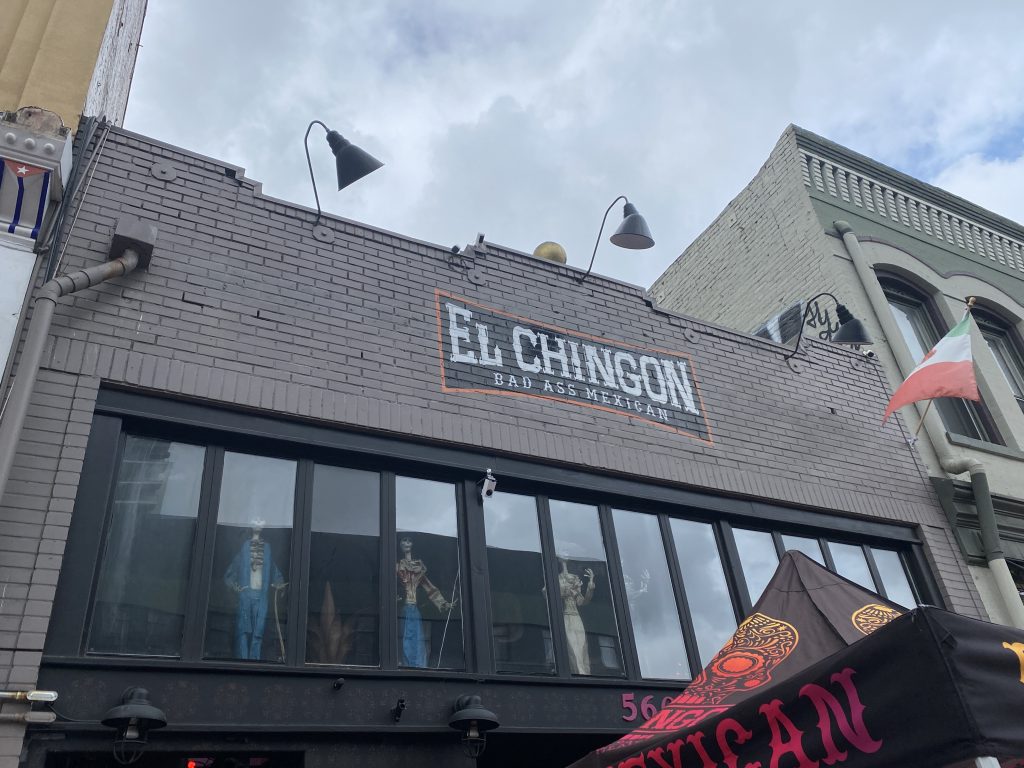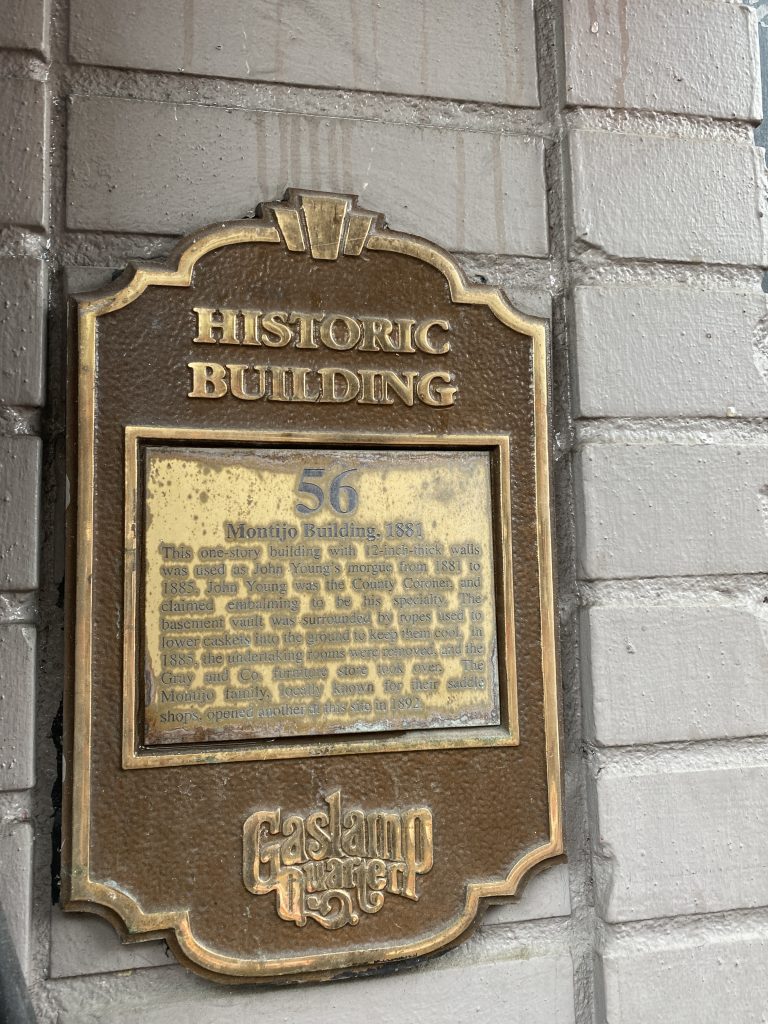No products in the cart.
Landmarks
From Corpses to Cafes!
The Montijo Building
1881 & 1887
560 5th Avenue
Architect: Unknown
Architectural Style: Commercial
When strolling in the Gaslamp, many are awestruck by the architecture and beauty of some of the buildings, while other buildings barely warrant a nod. In fact, many might wonder why they are even designated as historic. Never judge a book by its cover – some of these plain nondescript structures have very interesting stories to tell. One such building is the plain, one-story building just off 5th and Market called the Montijo.
When Alonzo Horton sold the property on 5th St. in November of 1867, there was no evidence of a structure on the property. Although, by the early 1870s, the area was well occupied by numerous frame buildings. The original lot owner, Mr. Olcott Pierce, engaged in a series of convoluted leases with various individuals, culminating with the sale of his property to one of his lessees, Josiah Lemuel Rowe. The sale was executed only four days before Pierce expired. The new owner , J.L. Rowe was a property owner and real estate speculator, as many were at that time. Unfortunately, he did not fare much better that Mr. Pierce, as according to the San Diego Union, “ he succumbed to a severe (brain) hemorrhage while engaging in business at the courthouse.” He passed away on July 20, 1880 at the age of 39. His obituary stated that he had come to San Diego from Michigan for his health.
The year before his untimely death, however, Mr. Rowe had leased the north half of his property to John Nelson Young and John Gray. The complicated lease, which also involved Mr. E. W. Tebbett, was to run for 5 years, with Young, Gray and Tebbett paying $5.00 per month, plus “all city, county and state taxes.” A former tenant, shoe and bootmaker, Phillip Brady, had vacated the premises entirely, so a structure now on the adjoining half of the lot was also relegated to Young, Gray and Tebbett. Thus, the Sanborn Fire Map of 1883, shows an undertaker on the north side of the lot, while a furniture store occupied the south side. John Young, a noted San Diego undertaker, had entered into a partnership with John Gray, a furniture dealer in 1876, which explains the signage. in 1881, Young received a contract to bury the indigent dead at $15 per capita, and was additionally appointed the Superintendent of the Cemetery grounds. He operated his mortuary business at the site between 1881 and 1885. The furniture store was entitled Gray and Company Furniture Store, and later shortened to Gray and Company. Ultimately the two businesses consolidated and moved into John Young’s new, three-story brick building next door. (Marin Hotel ).
In 1887 the building was torn down to make way for a new structure. The new building was a single-story, brick structure with a brick or metal cornice. It stood 17 feet high from the ground to the roof line, and had 12 inch thick walls. A double door was in the center front, with 10 small (2 x 4’) rectangular thick glass windows above it. It was nothing very exciting to look at, but served Young, Gray and Tebbett well until they moved to their new and much more elaborate structure in the adjoining lot.
The new tenant, George Montijo, was a colorful person and somewhat of a local legend. He arrived in San Diego from Marin County via covered wagon in 1881. His family had been saddle makers, and he continued this tradition by initially opening a store at 5th and “I” St. He had a life sized paper mache horse on the curb in front of the store, which was later seen in front of various businesses throughout the Gaslamp. Montijo moved to the building on 5th close to Market in 1892, and was listed in the San Diego Directory as “Saddlers and Harness Makers.” He claimed that his saddles “were famous throughout the southwest” and that he “helped introduce the western saddle to the Midwest.”
In 1891, Montijo became a candidate for Constable, but was questioned about an incident from his previous more youthful days. According to the San Diego Union, he was intoxicated, pulled a knife and had to be arrested with the help of a “six-shooter.” He spent the night in jail, and was fined $25. He was later fined again for damages done to the jail during his stay! Colorful? Yes! Constable? Probably not! In his old age though, he was named Honorary Mayor of San Ysidro.
In 1895, after a brief remodeling and the addition of a large skylight, the building became a cafe, the Model Restaurant. The proprietor was H. Schulz. The building remained the Model until 1912, when it became the
George Felice restaurant. In 1914, it became Rigopoulas and Nichols, and remained such until 1922. The property then became K. Kawamoto’s Frisco Cafe until 1939. However, because of the distrust of Japanese names during World War II, a Tommy Leung took over the property until 1947. It became Wing on Wong until 1950, when it reverted back to the Frisco Cafe until 1972. In 1972, it emerged as the Zebra Club, a very popular live music venue. in 1980, it became the Saigon Palace, advertised as a bar with live music. Unfortunately, they had sewage problems, and were forced to close in the late 1980s. The next restaurant to open, after a major remodel and plumbing upgrade, was Nicky Rottens, a sports bar, burgers and beer restaurant. Extremely popular, with burgers billed as “literally to big to eat.” It was replaced in 2015 by “19,” another sports bar.

The latest tenant in the long line of restaurants at the Montijo is El Chingon, billed as “Bad Ass Mexican,” and inspired by Pancho Villa and the Mexican Revolution. They offer curated tequilas, mescals and a special late night menu. They are one of the most popular venues for the the younger crowd and are always lively.
Sandee is the Historian/Lead Tour Guide for the Gaslamp Quarter Historical Foundation. She can be reached at [email protected].

